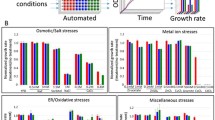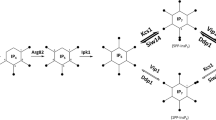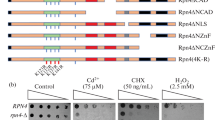Abstract
SPI1 is a gene whose expression responds to many environmental stimuli, including entry into stationary phase. We have performed a screening to identify genes that activate SPI1 promoter when overexpressed. The phosphatidylinositol-4-phosphate 5-kinase gene MSS4 was identified as a positive activator of SPI1. Another SPI1 transcriptional regulator isolated was the flavodoxin-like gene YCP4. YCP4 and its homolog RFS1 regulate the expression of many genes during the late stages of growth. The double deletion mutant in YCP4 and its homolog RFS1 has an impact on gene expression related to metabolism by increasing the expression of genes involved in hexose transport and glycolysis, and decreasing expression of genes of amino acid metabolism pathways. Genes related to mating and response to pheromone show a decreased expression in the double mutant, while transcription of genes involved in translational elongation is increased. Deletion of these genes, together with the third member of the family, PST2, has a complex effect on the stress response. For instance, double mutant ycp4Δrfs1Δ has an increased response to oxidative stress, but a decreased tolerance to cell-damaging agent SDS. Additionally, this mutation affects chronological aging and slightly increases fermentative capacity.





Similar content being viewed by others
References
Adams A, Gottschlings DE, Kaiser CA, Stearns T (1997) Methods in yeast genetics. Cold Spring Harbor Laboratory Press, New York
Cardona F, Carrasco P, Pérez-Ortín JE, del Olmo M, Aranda A (2007) A novel approach for the improvement of stress resistance in wine yeasts. Int J Food Microbiol 114:83–91
Cardona F, Aranda A, del Olmo M (2009) Ubiquitin ligase Rsp5p is involved in the gene expression changes during nutrient limitation in Saccharomyces cerevisiae. Yeast 26:1–15
Carey J, Brynda J, Wolfová J, Grandori R, Gustavsson T, Ettrich R, Smatanová IK (2007) WrbA bridges bacterial flavodoxins and eukaryotic NAD(P)H:quinone oxidoreductases. Protein Sci 16:2301–2305
Carrasco P, Querol A, del Olmo M (2001) Analysis of the stress resistance of commercial wine yeast strains. Arch Microbiol 175:450–457
Collins SR, Kemmeren P, Zhao XC, Greenblatt JF, Spencer F, Holstege FC, Weissman JS, Krogan NJ (2007) Toward a comprehensive atlas of the physical interactome of Saccharomyces cerevisiae. Mol Cell Proteomics 6:439–450
Daher BS, Venancio EJ, de Freitas SM, Báo SN, Vianney PV, Andrade RV, Dantas AS, Soares CM, Silva-Pereira I, Felipe MS (2005) The highly expressed yeast gene pby20 from Paracoccidioides brasiliensis encodes a flavodoxin-like protein. Fungal Genet Biol 42:434–443
Delom F, Szponarski W, Sommerer N, Boyer JC, Bruneau JM, Rossignol M, Gibrat R (2006) The plasma membrane proteome of Saccharomyces cerevisiae and its response to the antifungal calcofluor. Proteomics 6:3029–3039
Desrivieres S, Cooke FT, Parker PJ, Hall MN (1998) MSS4, a phosphatidylinositol-4-phosphate 5-kinase required for organization of the actin cytoskeleton in Saccharomyces cerevisiae. J Biol Chem 273:15787–15793
Fabrizio P, Longo VD (2003) The chronological life span of Saccharomyces cerevisiae. Aging Cell 2:73–81
Gasch AP, Spellman PT, Kao CM, Carmel-Harel O, Eisen MB, Storz G, Botstein D, Brown PO (2000) Genomic expression programs in the response of yeast cells to environmental changes. Mol Biol Cell 11:4241–4257
Gietz RD, Woods RA (2002) Transformation of yeast by the Liac/ss carrier DNA/PEG method. Methods Enzymol 350:87–96
Grandori R, Carey J (1994) Six new candidate members of the alpha/beta twisted open-sheet family detected by sequence similarity to flavodoxin. Protein Sci 3:2185–2193
Grandori R, Khalifah P, Boice JA, Fairman R, Giovanielli K, Carey J (1998) Biochemical characterization of WrbA, founding member of a new family of multimeric flavodoxin-like proteins. J Biol Chem 273:20960–20966
Grossmann G, Malinsky J, Stanhlschmidt W, Loibl M, Weig-Mekl I, Frommer WB, Opekarova M, Tanner E (2008) Plasma membrane microdomains regulate turnover of transport proteins in yeast. J Cell Biol 183:1075–1088
Guarente L (2000) Sir2 links chromatin silencing, metabolism, and aging. Genes Develop 14:1021–1026
Herman PK (2002) Stationary phase in yeast. Curr Opin Microbiol 5:692–697
Huh WK, Falvo JV, Gerke LC, Carroll AS, Howson RW, Weissman JS, O’Shea EK (2003) Global analysis of protein localization in budding yeast. Nature 425:686–691
Jakubowski W, Biliński T, Bartosz G (2000) Oxidative stress during aging of stationary cultures of the yeast Saccharomyces cerevisiae. Free Radic Biol Med 28:659–664
Jazwinski SM (2000) Metabolic control and gene dysregulation in yeast aging. Annals N Y Acad Sci 908:21–30
Jimenez-Marti E, del Olmo M (2008) Addition of ammonia or amino acids to a nitrogen-depleted medium affects gene expression patterns in yeast cells during alcoholic fermentation. FEMS Yeast Res 8:245–256
Kapteyn JC, Van Den Ende H, Klis FM (1999) The contribution of cell wall proteins to the organization of the yeast cell wall. Biochim Biophys Acta 1426:373–383
Kwan JJ, Warner N, Maini J, Chan Tung KW, Zakaria H, Pawson T, Donaldson LW (2006) Saccharomyces cerevisiae Ste50 binds the MAPKKK Ste11 through a head-to-tail SAM domain interaction. J Mol Biol 356(1):142–154
Lai LC, Kosorukoff AL, Burke PV, Kwast KE (2005) Dynamical remodeling of the transcriptome during short-term anaerobiosis in Saccharomyces cerevisiae: differential response and role of Msn2 and/or Msn4 and other factors in galactose and glucose media. Mol Cell Biol 25:4075–4091
Lee J, Godon C, Lagniel G, Spector D, Garin J, Labarre J, Toledano MB (1999) Yap1 and Skn7 control two specialized oxidative stress response regulons in yeast. J Biol Chem 274:16040–16046
Longtine MS, McKenzie A III, Demarini DJ, Shah NG, Wach A, Brachat A, Philippsen P, Pringle JR (1998) Additional modules for versatile and economical PCR-based gene deletion and modification in Saccharomyces cerevisiae. Yeast 14:953–961
Martínez MJ, Roy S, Archuletta AB, Wentzell PD, Anna-Arriola SS, Rodriguez AL, Aragon AD, Quiñones GA, Allen C, Werner-Washburne M (2004) Genomic analysis of stationary-phase and exit in Saccharomyces cerevisiae: gene expression and identification of novel essential genes. Mol Biol Cell 15:5295–5305
Monteiro PT, Mendes ND, Teixeira MC, d’Orey S, Tenreiro S, Mira NP, Pais H, Francisco AP, Carvalho AM, Lourenço AB, Sá-Correia I, Oliveira AL, Freitas AT (2008) YEASTRACT-DISCOVERER: new tools to improve the analysis of transcriptional regulatory associations in Saccharomyces cerevisiae. Nucleic Acids Res 36((Database issue)):D132–D136
Naresh A, Saini S, Singh J (2003) Identification of Uhp1, a ubiquitinated histone-like protein, as a target/mediator of Rhp6 in mating-type silencing in fission yeast. J Biol Chem 278:9185–9194
Núñez L, González-Siso MI, Becerra M, Cerdán ME (2007) Functional motifs outside the kinase domain of yeast Srb10p. Their role in transcriptional regulation and protein-interactions with Tup1p and Srb11p. Biochim Biophys Acta 1774(9):1227–1235
Ozcan S, Johnston M (1995) Three different regulatory mechanisms enable yeast hexose transporter (HXT) genes to be induced by different levels of glucose. Mol Cell Biol 15:1564–1572
Pardo M, Ward M, Bains S, Molina M, Blackstock W, Gil C, Nombela C (2000) A proteomic approach for the study of Saccharomyces cerevisiae cell wall biogenesis. Electrophoresis 21:3396–3410
Patridge EV, Ferry JG (2006) WrbA from Escherichia coli and Archaeoglobus fulgidus is an NAD(P)H:quinone oxidoreductase. J Bacteriol 188:3498–3506
Puig S, Pérez-Ortín JE (2000) Stress response and expression patterns in wine fermentations of yeast genes induced at the diauxic shift. Yeast 16:139–148
Queralt E, Igual JC (2005) Functional connection between the Clb5 cyclin, the protein kinase C pathway and the Swi4 transcription factor in Saccharomyces cerevisiae. Genetics 171:1485–1498
Reinders A, Bürckert N, Boller T, Wiemken A, De Virgilio C (1998) Saccharomyces cerevisiae cAMP-dependent protein kinase controls entry into stationary phase through the Rim15p protein kinase. Genes Dev 12:2943–2955
Roth AF, Wan J, Bailey AO, Sun B, Kuchar JA, Green WN, Phinney BS, Yates JR 3rd, Davis NG (2006) Global analysis of protein palmitoylation in yeast. Cell 125:1003–1013
Sancho J (2006) Flavodoxins: sequence, folding, binding, function and beyond. Cell Mol Life Sci 63:855–864
Sickmann A, Reinders J, Wagner Y, Joppich C, Zahedi R, Meyer HE, Schönfisch B, Perschil I, Chacinska A, Guiard B, Rehling P, Pfanner N, Meisinger C (2003) The proteome of Saccharomyces cerevisiae mitochondria. Proc Natl Acad Sci USA 100:13207–13212
Simões T, Mira NP, Fernandes AR, Sá-Correia I (2006) The SPI1 gene, encoding a glycosylphosphatidylinositol-anchored cell wall protein, plays a prominent role in the development of yeast resistance to lipophilic weak-acid food preservatives. Appl Environ Microbiol 72:7168–7175
Uetz P, Giot L, Cagney G, Mansfield TA, Judson RS, Knight JR, Lockshon D, Narayan V, Srinivasan M, Pochart P, Qureshi-Emili A, Li Y, Godwin B, Conover D, Kalbfleisch T, Vijayadamodar G, Yang M, Johnston M, Fields S, Rothberg JM (2000) A comprehensive analysis of protein-protein interactions in Saccharomyces cerevisiae. Nature 403:623–627
Valencia-Burton M, Oki M, Johnson J, Seier TA, Kamakaka R, Haber JE (2006) Different mating-type-regulated genes affect the DNA repair defects of Saccharomyces RAD51, RAD52 and RAD55 mutants. Genetics 174:41–55
Wong Sak Hoi J, Bernard D (2010) Ste12 and Ste12-like proteins, fungal transcription factors regulating development and pathogenicity. Euk Cell 9:480–485
Yang W, Ni L, Somerville RL (1993) A stationary-phase protein of Escherichia coli that affects the mode of association between the trp repressor protein and operator-bearing DNA. Proc Natl Acad Sci USA 90:5796–5800
Yang IV, Chen E, Hasseman JP, Liang W, Frank BC, Wang S, Sharov V, Saeed AI, White J, Li J, Lee NH, Yeatman TJ, Quackenbush J (2002) Within the fold: assessing differential expression measures and reproducibility in microarray assays. Genome Biol 3:0062.1–0062.12
Acknowledgments
We thank Chirag Sheth for the critical review of this manuscript. We are indebted to J.C. Igual for the multicopy library. This work has been supported by grants AGL2005-00508 and AGL2008-00060 from the “Ministerio de Educación y Ciencia” to M.O. and A.A. respectively and GRUPOS03/012 from the “Generalitat Valenciana” to both; F.C. was a F.P.U. fellow of the “Ministerio de Educación”.
Author information
Authors and Affiliations
Corresponding author
Additional information
Communicated by Axel Braghage.
Electronic supplementary material
Below is the link to the electronic supplementary material.
203_2011_696_MOESM1_ESM.pdf
Lack of effect of hor2 deletion on SPI1 expression. SPI1 expression tested by northern blot in wild-type strain BY4742 and hor2Δ strain under control conditions (exponential, EXP) and post-diauxic phase (PD) in rich medium. The data shown correspond to the relative amounts of SPI1 mRNA relative to rRNA, and for the same strain transformed with the corresponding empty plasmid. All experiments were carried out in triplicate, and the standard deviation is indicated (PDF 45 kb)
203_2011_696_MOESM2_ESM.pdf
Alignment of flavodoxin-like proteins in S. cerevesiae (A) and other organisms (B). The sequences of Ycp4, Pst2 and Rfs1 of S. cerevisiae (Sc), PbY20 of Paracoccidioides brasiliensis (Pb), Uhp1 of Schyzosaccharomyces pombe (Sp) and Wrba of E. coli (Ec) were taken from NCBI, and the program ClustalX 1.83 was used for the alignment. The last 40 amino acids of Ycp4_Sc are omitted as they were not present in other proteins (PDF 46 kb)
203_2011_696_MOESM3_ESM.pdf
Plasmid loss in mutants of flavodoxin-like genes. Yeast strains transformed with YEPlac357 (A) and the SPI1-lacZ containing plasmids (B) were grown in non-selective medium (YPD), and dilutions were plated on both selective (SC-URA) and non-selective medium (YPD). The percentage of colonies present on the SC-URA plates compared to the YPD plates is represented. Statistically significant data are indicated by *** (p-value<=0.0005) (PDF 46 kb)
203_2011_696_MOESM4_ESM.pdf
Scheme of the results obtained in differential expression between wild-type and mutant ycp4Δrfs1Δ from microarray experiments. Only the genes related to central cellular metabolism are shown. Green text indicates genes differentially expressed at least twofold, and red text indicates those differentially expressed more than twofold in the double mutant compared to wild-type. Relationships with the metabolism of amino acids are shown in blue. The red or green boxes highlight the metabolites whose levels are increased or decreased (respectively) in the double null mutant ycp4Δrfs1Δ. Purple text show up-regulated genes in the ycp4Δ single mutant, whilst red text with an asterisk indicates those overexpressed in both mutants (PDF 95 kb)
203_2011_696_MOESM5_ESM.pdf
Semiquantitative RT–PCR confirmation of selected results obtained by microarray analysis in ycp4Δrfs1Δ strain. A representative result of the replicate analysis carried out with RNA from two independent cultures is shown. ACT1 was used as constitutive gene (PDF 79 kb)
Rights and permissions
About this article
Cite this article
Cardona, F., Orozco, H., Friant, S. et al. The Saccharomyces cerevisiae flavodoxin-like proteins Ycp4 and Rfs1 play a role in stress response and in the regulation of genes related to metabolism. Arch Microbiol 193, 515–525 (2011). https://doi.org/10.1007/s00203-011-0696-7
Received:
Revised:
Accepted:
Published:
Issue Date:
DOI: https://doi.org/10.1007/s00203-011-0696-7




